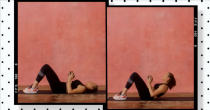Welcome to our weekly Move of the Week series. Every Monday, we’ll be sharing with you one of our favourite exercises – how to do them, what muscles they work and why they should be a regular part of your workout regime. This week: weighted crunches.
If you’ve been doing the same circuit of ab exercises every week for months on end, your workout probably needs a makeover. And how about adding weights to some of the classic moves?
Don’t be scared. Crunches alone are tough and with weights, they’re even harder. But the benefits you get from adding extra resistance to the infamous ab workout far outweigh the fear of trying.
You may also like
Move of the week: puppy dog pose eases a stiff upper back and tight chest
What is a weighted crunch?
A weighted crunch involves lying on the floor and lifting your upper body off the ground but with the extra challenge of a dumbbell.
This exercise is great because:
It builds strength: adding extra resistance helps your body get stronger.
It challenges the body: using different variations of exercises offers different a stimulus to keep your body adapting.
It can reduce back pain: a strong core improves posture and reduces pain.
What muscles are worked in a weighted crunch?
This core move mainly targets:
- Transverse abdominals (the top layer of abs_
- Rectus abdominals (the deep core)
- Obliques (side of the body)
- Hip flexors
You may also like
Reverse lunge your way to injury-proof key running muscles
How to do weighted crunches
- Lie on the floor with your feet flat on the ground and knees bent to point towards the ceiling.
- Hold a dumbell with either head in your hands over your chest with your elbows bent at 90 degrees.
- Dig your heels into the ground and squeeze your core as you lift your head and shoulders off the mat.
- Slowly lower back down.
For more exercise tips, sign up to the Strong Women Training Club.
Images: Stylist
Source: Read Full Article
